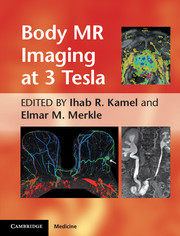Book contents
- Frontmatter
- Contents
- Contributors
- Foreword
- Preface
- Chapter 1 Body MR imaging at 3T: basic considerations about artifacts and safety
- Chapter 2 Novel acquisition techniques that are facilitated by 3T
- Chapter 3 Breast MR imaging
- Chapter 4 Cardiac MR imaging
- Chapter 5 Abdominal and pelvic MR angiography
- Chapter 6 Liver MR imaging at 3T: challenges and opportunities
- Chapter 7 MR imaging of the pancreas
- Chapter 8 MR imaging of the adrenal glands
- Chapter 9 Magnetic resonance cholangiopancreatography
- Chapter 10 MR imaging of small and large bowel
- Chapter 11 MR imaging of the rectum, 3T vs. 1.5T
- Chapter 12 Imaging of the kidneys and MR urography at 3T
- Chapter 13 MR imaging and MR-guided biopsy of the prostate at 3T
- Chapter 14 Female pelvic imaging at 3T
- Index
- Plate section
- References
Chapter 8 - MR imaging of the adrenal glands
Published online by Cambridge University Press: 05 August 2011
- Frontmatter
- Contents
- Contributors
- Foreword
- Preface
- Chapter 1 Body MR imaging at 3T: basic considerations about artifacts and safety
- Chapter 2 Novel acquisition techniques that are facilitated by 3T
- Chapter 3 Breast MR imaging
- Chapter 4 Cardiac MR imaging
- Chapter 5 Abdominal and pelvic MR angiography
- Chapter 6 Liver MR imaging at 3T: challenges and opportunities
- Chapter 7 MR imaging of the pancreas
- Chapter 8 MR imaging of the adrenal glands
- Chapter 9 Magnetic resonance cholangiopancreatography
- Chapter 10 MR imaging of small and large bowel
- Chapter 11 MR imaging of the rectum, 3T vs. 1.5T
- Chapter 12 Imaging of the kidneys and MR urography at 3T
- Chapter 13 MR imaging and MR-guided biopsy of the prostate at 3T
- Chapter 14 Female pelvic imaging at 3T
- Index
- Plate section
- References
Summary
Introduction
An adrenal “incidentaloma” is an adrenal mass, 1 cm or more in diameter, which is incidentally discovered during a radiologic examination performed for indications other than an evaluation for adrenal disease. With the widespread use of abdominal ultrasonography, multi-detector row computed tomography (MDCT), magnetic resonance (MR) imaging, and positron emission tomography (PET) the incidence of adrenal incidentalomas has substantially increased. According to recent studies, the overall frequency of adrenal masses is approximately 4% at abdominal MDCT [1], which compares favorably with the 6% prevalence rate reported in a large autopsy study [2]. Although the majority of adrenal incidentalomas are clinically benign adenomas, other frequently reported diagnoses include metastases, pheochromocytomas, and adrenocortical carcinomas. The differential diagnosis between benign and malignant adrenal masses has become a common dilemma, which is compounded in patients with known or suspected of having an extra-adrenal malignancy, where approximately 50% of incidentally detected adrenal lesions are metastatic disease [3].
- Type
- Chapter
- Information
- Body MR Imaging at 3 Tesla , pp. 111 - 122Publisher: Cambridge University PressPrint publication year: 2011



